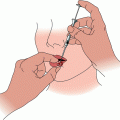Armand B. Cognetta Jr. and William M. Mendenhall (eds.)Radiation Therapy for Skin Cancer201310.1007/978-1-4614-6986-5_20© Springer Science+Business Media New York 2013
Getting Started in Superficial Radiation for the Dermatology Practice
(1)
Dermatologic Surgery Specialists, PC, 308 Coliseum Drive #200, Macon, GA 31217, USA
Abstract
Management of nonmelanoma skin cancer (NMSC) is routinely performed by dermatologist and nondermatologist’s practices in both an office setting and outpatient surgery centers. Traditional treatment options include surgical (excision with and without frozen section evaluation, Mohs surgery, curettage, and electrodesiccation) and nonsurgical options (topical therapies and radiation therapy).
Introduction
Management of nonmelanoma skin cancer (NMSC) is routinely performed by dermatologist and nondermatologist’s practices in both an office setting and outpatient surgery centers. Traditional treatment options include surgical (excision with and without frozen section evaluation, Mohs surgery, curettage, and electrodesiccation) and nonsurgical options (topical therapies and radiation therapy).
Many patients that present for management of NMSC are candidates for nonsurgical treatment with radiation. Up to this point, radiation centers using linear accelerators with electrons delivered in a concrete bunker have been the primary option. Those patients with poor health who may be elderly and frail, or who want to avoid potential scarring are prime candidates for superficial X-ray therapy. As noted, dermatologists were at the forefront of utilizing ionizing radiation for NMSC with superficial X-ray machines. They have been involved with delivering superficial X-ray treatments for over one century. Until recently, there have been few if any options for purchasing new updated equipment for providing this service in an office setting safely and efficiently. Superficial X-ray therapy for NMSC in dermatology offices was limited to machines that were dated and at times temperamental.
Now with the availability of updated new superficial X-ray machines, the supply issue is solved. Making the decision to provide superficial X-ray for treatment of NMSC rests on the dermatologist’s ability to critically examine their practice’s suitability for this service. The following discussion is aimed to assist the dermatologists at examining their practice for suitability in adding this modality for managing NMSC. It is important to note from the onset that the patients who will receive superficial X-ray will comprise a minority of NMSC patients. Patient selection is key just as it is in all fields of medicine. Our discussion will transit the physician through the stages necessary for considering “getting started” with superficial X-ray. The main steps involved in this process include: planning, purchase, implementation, regulatory issues including potential outside negative forces, staff and physician training, and all supporting educational information and documentation forms.
Planning
In the planning stage of assessing a medical practice’s suitability for adding superficial X-ray, the physician or practice administrator must critically look at several key questions:
1.
Does the practice have a volume of skin cancer patients who will fit the profile of the “ideal candidate” for superficial X-ray?
2.
What lesional criteria are necessary in order to be considered for superficial X-ray? What will we treat and what will we not treat?
3.
Does the physician and practice currently specialize in managing a wide range of NMSC? Or, is the practice geared toward managing only a narrow patient profile for NMSC or more focused on other aspects of dermatological care including cosmetic services?
4.
Does the practice have sufficient space that is appropriately located and accessible?
5.
Is the practice committed to adding the personnel required?
6.
Is the physician willing to commit to becoming expert in all phases of superficial X-ray therapy for their patients? This will require training or retraining in areas that include radiation biology and physics. Many of us have had didactic training in our residency or through the AAD annual meeting. Some of us have been “exposed” to radiation by our older colleagues or while in training.






